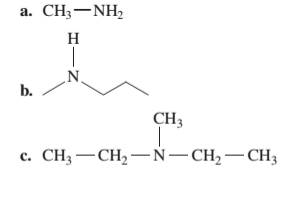
EBK BASIC CHEMISTRY
5th Edition
ISBN: 8220101472335
Author: Timberlake
Publisher: PEARSON
expand_more
expand_more
format_list_bulleted
Concept explainers
Textbook Question
Chapter 17.7, Problem 17.53QAP
Write the common name for each of the following:

Expert Solution & Answer
Want to see the full answer?
Check out a sample textbook solution
Students have asked these similar questions
Complete and balance the following half-reaction in basic solution. Be sure to include the proper phases for all species within the reaction.
Zn(s) → Zn(OH)₄²⁻(aq)
b.
ὋΗ
CH3CH2OH
H2SO4
For the reaction A (g) → 3 B (g), Kp = 0.379 at 298 K. What is the value of ∆G for this reaction at 298 K when the partial pressures of A and B are 5.70 atm and 0.250 atm?
Chapter 17 Solutions
EBK BASIC CHEMISTRY
Ch. 17.1 - LEARNING GOAL Write the IUPAC names and draw the...Ch. 17.1 - Prob. 17.2QAPCh. 17.1 - Prob. 17.3QAPCh. 17.1 - Prob. 17.4QAPCh. 17.1 - Prob. 17.5QAPCh. 17.1 - Prob. 17.6QAPCh. 17.1 - Prob. 17.7QAPCh. 17.1 - Prob. 17.8QAPCh. 17.1 - Prob. 17.9QAPCh. 17.1 - Prob. 17.10QAP
Ch. 17.2 - Prob. 17.11QAPCh. 17.2 - Prob. 17.12QAPCh. 17.2 - Prob. 17.13QAPCh. 17.2 - Prob. 17.14QAPCh. 17.2 - Prob. 17.15QAPCh. 17.2 - Prob. 17.16QAPCh. 17.2 - Prob. 17.17QAPCh. 17.2 - Prob. 17.18QAPCh. 17.2 - Prob. 17.19QAPCh. 17.2 - Prob. 17.20QAPCh. 17.2 - Prob. 17.21QAPCh. 17.2 - Prob. 17.22QAPCh. 17.2 - Prob. 17.23QAPCh. 17.2 - Prob. 17.24QAPCh. 17.3 - Prob. 17.25QAPCh. 17.3 - Prob. 17.26QAPCh. 17.3 - Prob. 17.27QAPCh. 17.3 - Prob. 17.28QAPCh. 17.4 - Prob. 17.29QAPCh. 17.4 - Prob. 17.30QAPCh. 17.4 - Prob. 17.31QAPCh. 17.4 - Prob. 17.32QAPCh. 17.4 - Prob. 17.33QAPCh. 17.4 - Prob. 17.34QAPCh. 17.5 - Prob. 17.35QAPCh. 17.5 - Prob. 17.36QAPCh. 17.5 - Prob. 17.37QAPCh. 17.5 - Prob. 17.38QAPCh. 17.5 - Prob. 17.39QAPCh. 17.5 - Prob. 17.40QAPCh. 17.6 - Prob. 17.41QAPCh. 17.6 - Prob. 17.42QAPCh. 17.6 - Prob. 17.43QAPCh. 17.6 - Prob. 17.44QAPCh. 17.6 - Prob. 17.45QAPCh. 17.6 - Prob. 17.46QAPCh. 17.6 - Prob. 17.47QAPCh. 17.6 - Prob. 17.48QAPCh. 17.6 - Prob. 17.49QAPCh. 17.6 - Prob. 17.50QAPCh. 17.6 - Prob. 17.51QAPCh. 17.6 - Draw the condensed structural formula for each of...Ch. 17.7 - Write the common name for each of the following:Ch. 17.7 - Prob. 17.54QAPCh. 17.7 - Prob. 17.55QAPCh. 17.7 - Prob. 17.56QAPCh. 17.7 - Prob. 17.57QAPCh. 17.7 - Prob. 17.58QAPCh. 17.7 - Prob. 17.59QAPCh. 17.7 - Prob. 17.60QAPCh. 17 - Prob. 17.61FUCh. 17 - 17.62 New polymers have been synthesized to...Ch. 17 - Prob. 17.63FUCh. 17 - Prob. 17.64FUCh. 17 - Prob. 17.65UTCCh. 17 - Prob. 17.66UTCCh. 17 - Prob. 17.67UTCCh. 17 - Prob. 17.68UTCCh. 17 - Prob. 17.69AQAPCh. 17 - Prob. 17.70AQAPCh. 17 - Prob. 17.71AQAPCh. 17 - Prob. 17.72AQAPCh. 17 - Prob. 17.73AQAPCh. 17 - Prob. 17.74AQAPCh. 17 - Prob. 17.75AQAPCh. 17 - Prob. 17.76AQAPCh. 17 - Prob. 17.77AQAPCh. 17 - Prob. 17.78AQAPCh. 17 - Prob. 17.79AQAPCh. 17 - Prob. 17.80AQAPCh. 17 - Prob. 17.81AQAPCh. 17 - Prob. 17.82AQAPCh. 17 - Prob. 17.83AQAPCh. 17 - Prob. 17.84AQAPCh. 17 - Prob. 17.85AQAPCh. 17 - Prob. 17.86AQAPCh. 17 - Prob. 17.87AQAPCh. 17 - Prob. 17.88AQAPCh. 17 - Prob. 17.89AQAPCh. 17 - Prob. 17.90AQAPCh. 17 - Prob. 17.91AQAPCh. 17 - Prob. 17.92AQAPCh. 17 - Draw the condensed structural formula for each of...Ch. 17 - Prob. 17.94AQAPCh. 17 - Prob. 17.95AQAPCh. 17 - Prob. 17.96AQAPCh. 17 - Prob. 17.97CQCh. 17 - Prob. 17.98CQCh. 17 - Prob. 17.99CQCh. 17 - Prob. 17.100CQCh. 17 - Prob. 17.101CQCh. 17 - Prob. 17.102CQ
Knowledge Booster
Learn more about
Need a deep-dive on the concept behind this application? Look no further. Learn more about this topic, chemistry and related others by exploring similar questions and additional content below.Similar questions
- 14. Calculate the concentrations of Ag+, Ag(S2O3), and Ag(S2O3)23- in a solution prepared by mixing 150.0 mL of 1.00×10-3 M AgNO3 with 200.0 mL of 5.00 M Na2S2O3 Ag+ + S20 Ag(S203)¯ K₁ = 7.4 × 108 Ag(S203)¯ + S20¯ = Ag(S203) K₂ = 3.9 x 104arrow_forwardΗΝ, cyclohexanone pH 4-5 Draw Enamine I I CH3CH2Br THF, reflux H3O+ I Drawing Draw Iminium Ionarrow_forward:0: :0: Select to Add Arrows :0: (CH3)2NH :0: ■ Select to Add Arrows :0: :0: (CH3)2NH ■ Select to Add Arrowsarrow_forward
- Draw the product of the following H action sequence. Ignore any inorganic byproducts formed. 1. (CH3CH2)2CuLi, THF 2. CH3Br Q Atoms, Bonds and Rings H Charges ㅁarrow_forwardPlease help me with this the problem is so confusingarrow_forward14 Question (1 point) Disiamylborane adds to a triple bond to give an alkenylborane. Upon oxidation with OH, H2O2, the alkenylborane will form an enol that tautomerizes to an aldehyde. In the first box below, draw the mechanism arrows for the reaction of disiamylborane with the alkyne, and in the last box draw the structure of the aldehyde. 4th attempt Feedback i > 3rd attempt OH, H2O2 i See Periodic Table See Hintarrow_forward
- answer with mechanisms and steps. handwritten please!arrow_forwardHello I need some help with Smartwork. For drawing structure B, I know the correct answer is CH₃B₂, but when I try to type it in, it keeps giving me CH₄BH₃ instead. Do you know how I should write it properly? Should I use a bond or something else?arrow_forwardTrue or false, chemistryarrow_forward
- answer thse questions with mechanisms and steps. handwritten please!arrow_forwardC app.aktiv.com Draw the product of the following reaction sequence. Ignore any inorganic byproducts formed. H O 1. (CH3CH2)2CuLi, THF 2. CH3Br Drawingarrow_forwardDraw the product of the following reaction sequence. Ignore any inorganic byproducts formed. H O 1. (CH3CH2)2CuLi, THF 2. CHзBr Drawingarrow_forward
arrow_back_ios
SEE MORE QUESTIONS
arrow_forward_ios
Recommended textbooks for you

 General, Organic, and Biological ChemistryChemistryISBN:9781285853918Author:H. Stephen StokerPublisher:Cengage Learning
General, Organic, and Biological ChemistryChemistryISBN:9781285853918Author:H. Stephen StokerPublisher:Cengage Learning Organic And Biological ChemistryChemistryISBN:9781305081079Author:STOKER, H. Stephen (howard Stephen)Publisher:Cengage Learning,
Organic And Biological ChemistryChemistryISBN:9781305081079Author:STOKER, H. Stephen (howard Stephen)Publisher:Cengage Learning,


General, Organic, and Biological Chemistry
Chemistry
ISBN:9781285853918
Author:H. Stephen Stoker
Publisher:Cengage Learning

Organic And Biological Chemistry
Chemistry
ISBN:9781305081079
Author:STOKER, H. Stephen (howard Stephen)
Publisher:Cengage Learning,
General Chemistry | Acids & Bases; Author: Ninja Nerd;https://www.youtube.com/watch?v=AOr_5tbgfQ0;License: Standard YouTube License, CC-BY